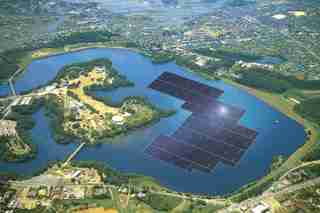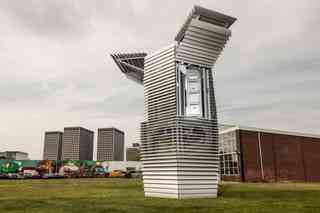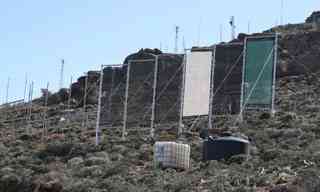6 Design Innovations That Prove Everything Will Be Okay
When we examine innovations in design, there is so much good being done in the name of the future. No longer, for example, are we just 3-D printing figures of animals or skyscrapers to display on our desks (as it once was when the technology was brand new). We’re also 3-D printing homes and bridges at a fraction of the price of traditional methods. Which means there are more opportunities to use technology toward the greater good. From an IKEA-made refugee shelter to smog-eating towers, AD rounds up six innovative designs that point to a bright future.

Floating Solar Panels
Japan, a country roughly the size of Montana, features a topography of mountains that are beautiful to look at but difficult to build on. Especially when it comes to constructing large energy factories. The country took matters into their own hands by announcing early last year their plans to build the world’s largest floating solar installation in terms of power produced. The 51,000 solar panels—which will live on the surface of the Yamakura Dam reservoir, roughly 43 miles southeast of Tokyo—will have a capacity of 16,170 megawatt hours per year. That means by the time the project is completed in 2018, the float solar panels will produce enough electricity to power nearly 5,000 households in the region.

Smog-Eating Tower
The World Health Organization estimates that air pollution causes 2.4 million deaths in China every year. Though many environmental innovations have been proposed in the country, one project that shows serious promise is the Smog Free Tower. Created by Dutch designer Daan Roosegaarde and his Netherlands-based team, the 23-foot-high structure, which was built in Beijing in 2016, operates as a giant air purifier, using ion technology to attract roughly 30,000 cubic meters of pollution per hour. True to its eco-friendly intent, the tower operates almost exclusively on wind energy.

Turning Fog into Drinkable Water
In 2015, after several years of testing, a group of German and Moroccan scientists built a series of nets that turn fog into drinkable water. Erected along the edges of the Sahara desert, in the dry and mountainous parts of southwest Morocco, the device uses fine meshing which catches fog droplets (which range from 1 to 40 millionth of a meter). Once enough fog has collected, a small droplet is formed, moving down the mesh and into a bucket. To date, the fresh water produced can hydrate 500 people in a nearby village.
3-D Printed Homes Made in 24 Hours
San Francisco–based start-up Apis Cor recently built an entire house from scratch in less than 24 hours using a special 3-D printer. The 400-square-foot dwelling was crafted using no prefabricated sections or pre-existing structure in place. And best of all is that the process cost just over $10,000. Once the walls are complete, human workers install the finishing touches, such as the roof, windows, doors, electrical wiring, and insulation.
IKEA-made Refugee Shelters
Winner of the 2016 Beazley Design of the Year, the Better Shelter—a collaboration between Johan Karlsson, Dennis Kanter, Christian Gustafsson, John van Leer, Tim de Haas, Nicolò Barlera, the IKEA Foundation, and UNHCR, the refugee agency of the United Nations—creates a temporary home for those in need. The shelter, which takes roughly four hours to assemble, boasts such features as a lockable front door, ventilation, and solar panels, which power lights and phone chargers.
Urban Cities in 2045
According to a report from the World Health Organization, in 2014 cities accounted for for 54 percent of the total global population, up from 34 percent in 1960, and continue to grow. This upward trend moved Japanese officials to launch an initiative called “Next Tokyo,” where architects would create a futuristic mega-city that is adapted to climate change in the year 2045. New York–based firm KPF and Leslie E. Robertson Associates joined forces to propose a vision for a new city in Tokyo Bay. Their design incorporates elements that improve the bay’s preparedness for natural disasters as well as a mile-high residential tower and a public-transportation-friendly district. Salt water from the bay would also be retained to grow algae, a source of renewable and clean fuel. The residential mega-skyscraper would house 55,000 people, with multilevel sky lobbies where residents would share amenities such as shopping centers, restaurants, hotels, gyms, libraries, and health clinics.